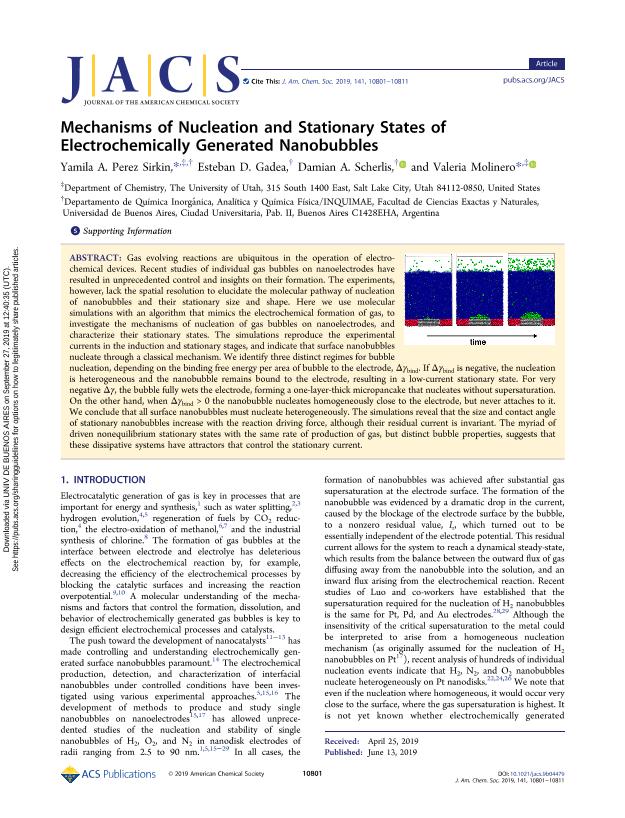Artículo
Mechanisms of Nucleation and Stationary States of Electrochemically Generated Nanobubbles
Pérez Sirkin, Yamila Anahí ; Gadea, Esteban David
; Gadea, Esteban David ; Scherlis Perel, Damian Ariel
; Scherlis Perel, Damian Ariel ; Molinero, Valeria
; Molinero, Valeria
 ; Gadea, Esteban David
; Gadea, Esteban David ; Scherlis Perel, Damian Ariel
; Scherlis Perel, Damian Ariel ; Molinero, Valeria
; Molinero, Valeria
Fecha de publicación:
07/2019
Editorial:
American Chemical Society
Revista:
Journal of the American Chemical Society
ISSN:
0002-7863
e-ISSN:
1520-5126
Idioma:
Inglés
Tipo de recurso:
Artículo publicado
Clasificación temática:
Resumen
Gas evolving reactions are ubiquitous in the operation of electrochemical devices. Recent studies of individual gas bubbles on nanoelectrodes have resulted in unprecedented control and insights on their formation. The experiments, however, lack the spatial resolution to elucidate the molecular pathway of nucleation of nanobubbles and their stationary size and shape. Here we use molecular simulations with an algorithm that mimics the electrochemical formation of gas, to investigate the mechanisms of nucleation of gas bubbles on nanoelectrodes, and characterize their stationary states. The simulations reproduce the experimental currents in the induction and stationary stages, and indicate that surface nanobubbles nucleate through a classical mechanism. We identify three distinct regimes for bubble nucleation, depending on the binding free energy per area of bubble to the electrode, ΔΓbind. If ΔΓbind is negative, the nucleation is heterogeneous and the nanobubble remains bound to the electrode, resulting in a low-current stationary state. For very negative ΔΓ, the bubble fully wets the electrode, forming a one-layer-thick micropancake that nucleates without supersaturation. On the other hand, when ΔΓbind > 0 the nanobubble nucleates homogeneously close to the electrode, but never attaches to it. We conclude that all surface nanobubbles must nucleate heterogeneously. The simulations reveal that the size and contact angle of stationary nanobubbles increase with the reaction driving force, although their residual current is invariant. The myriad of driven nonequilibrium stationary states with the same rate of production of gas, but distinct bubble properties, suggests that these dissipative systems have attractors that control the stationary current.
Palabras clave:
NANOBUBBLES
,
CNT
Archivos asociados
Licencia
Identificadores
Colecciones
Articulos(INQUIMAE)
Articulos de INST.D/QUIM FIS D/L MATERIALES MEDIOAMB Y ENERGIA
Articulos de INST.D/QUIM FIS D/L MATERIALES MEDIOAMB Y ENERGIA
Citación
Pérez Sirkin, Yamila Anahí; Gadea, Esteban David; Scherlis Perel, Damian Ariel; Molinero, Valeria; Mechanisms of Nucleation and Stationary States of Electrochemically Generated Nanobubbles; American Chemical Society; Journal of the American Chemical Society; 141; 27; 7-2019; 10801-10811
Compartir
Altmétricas



